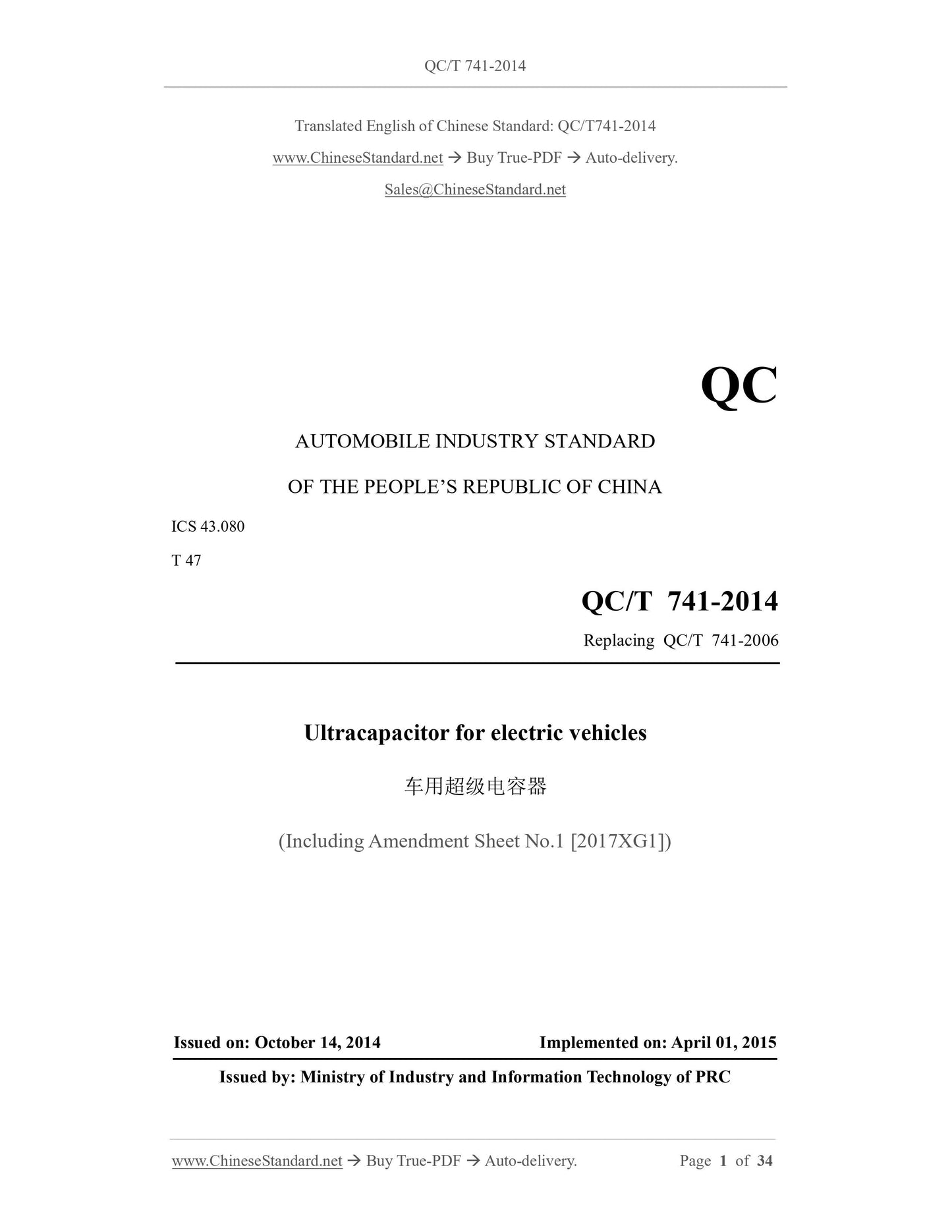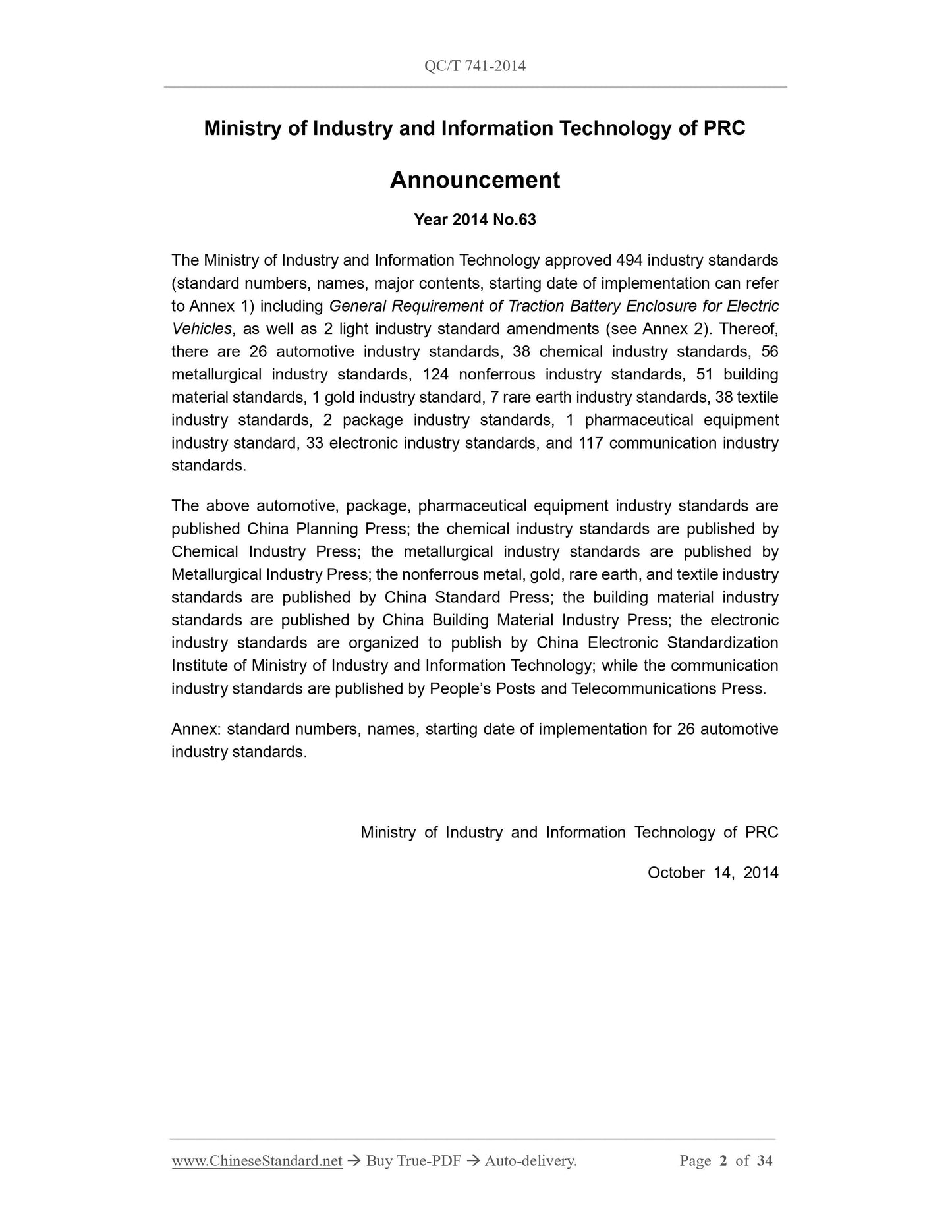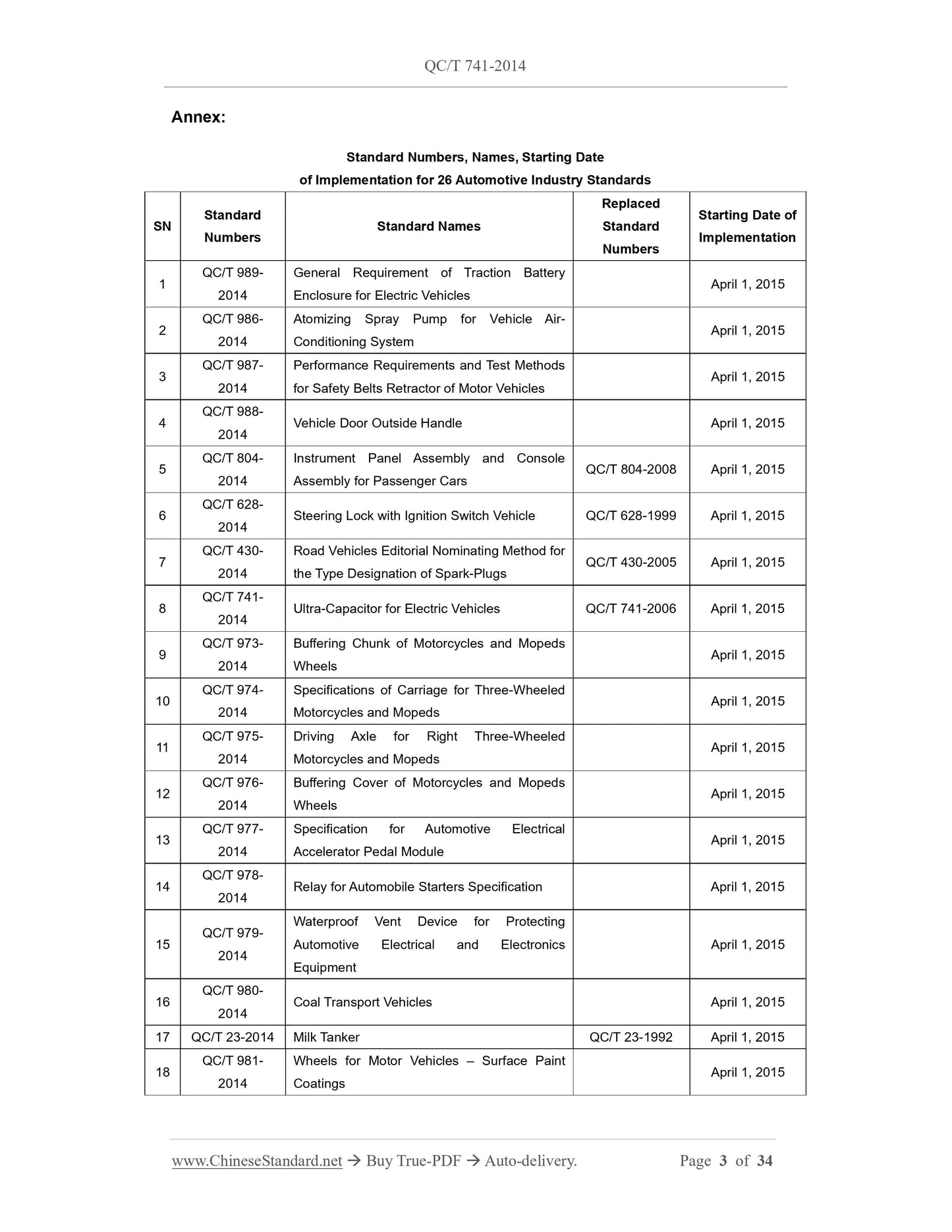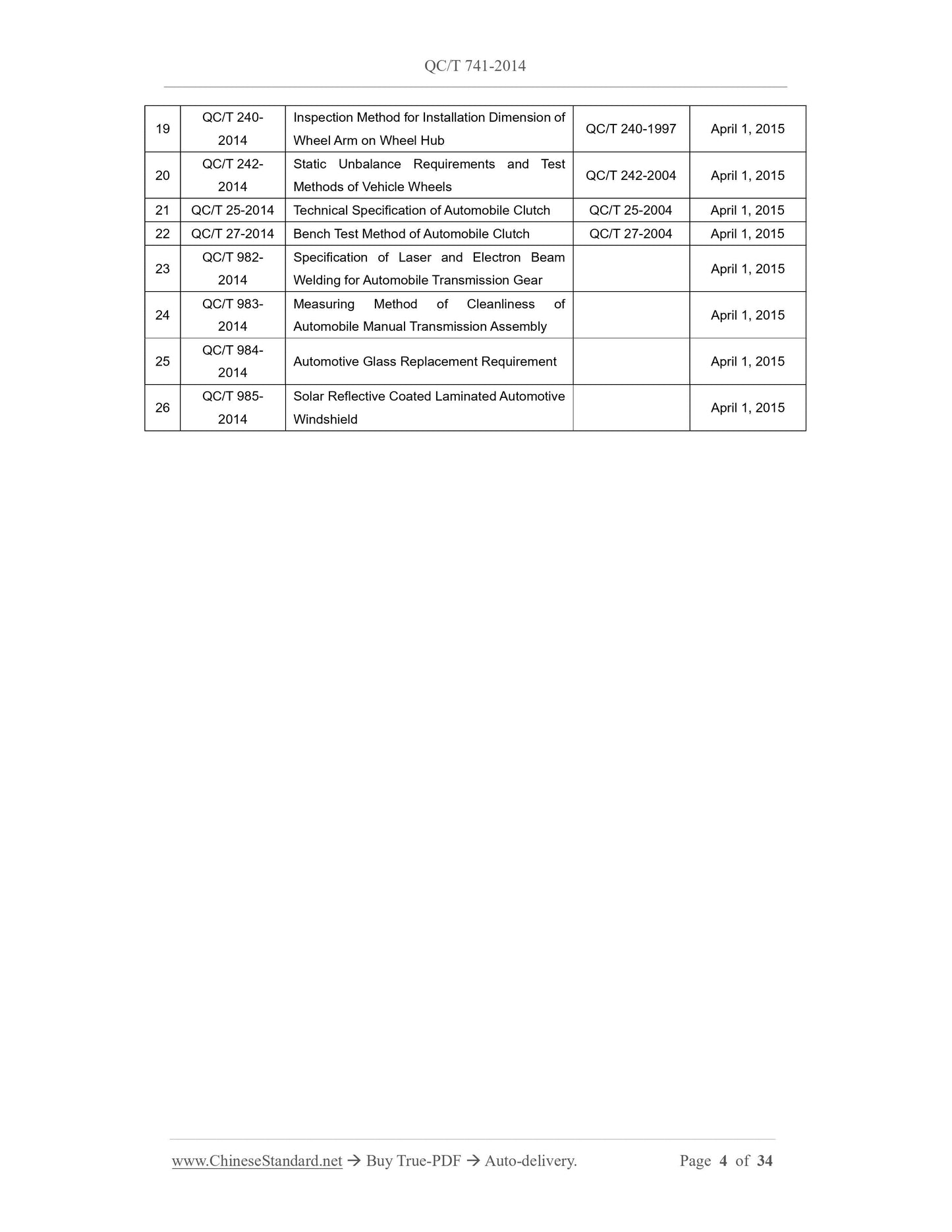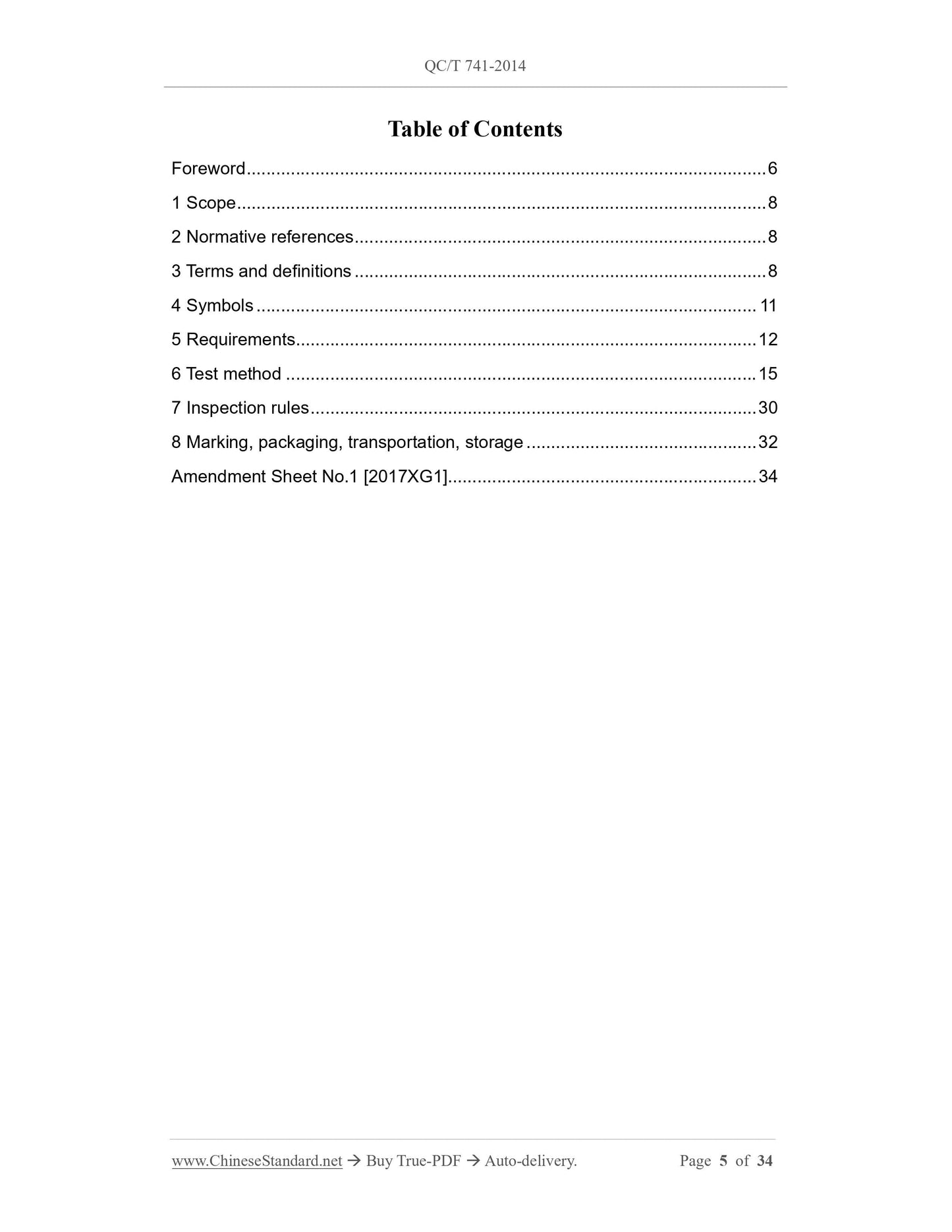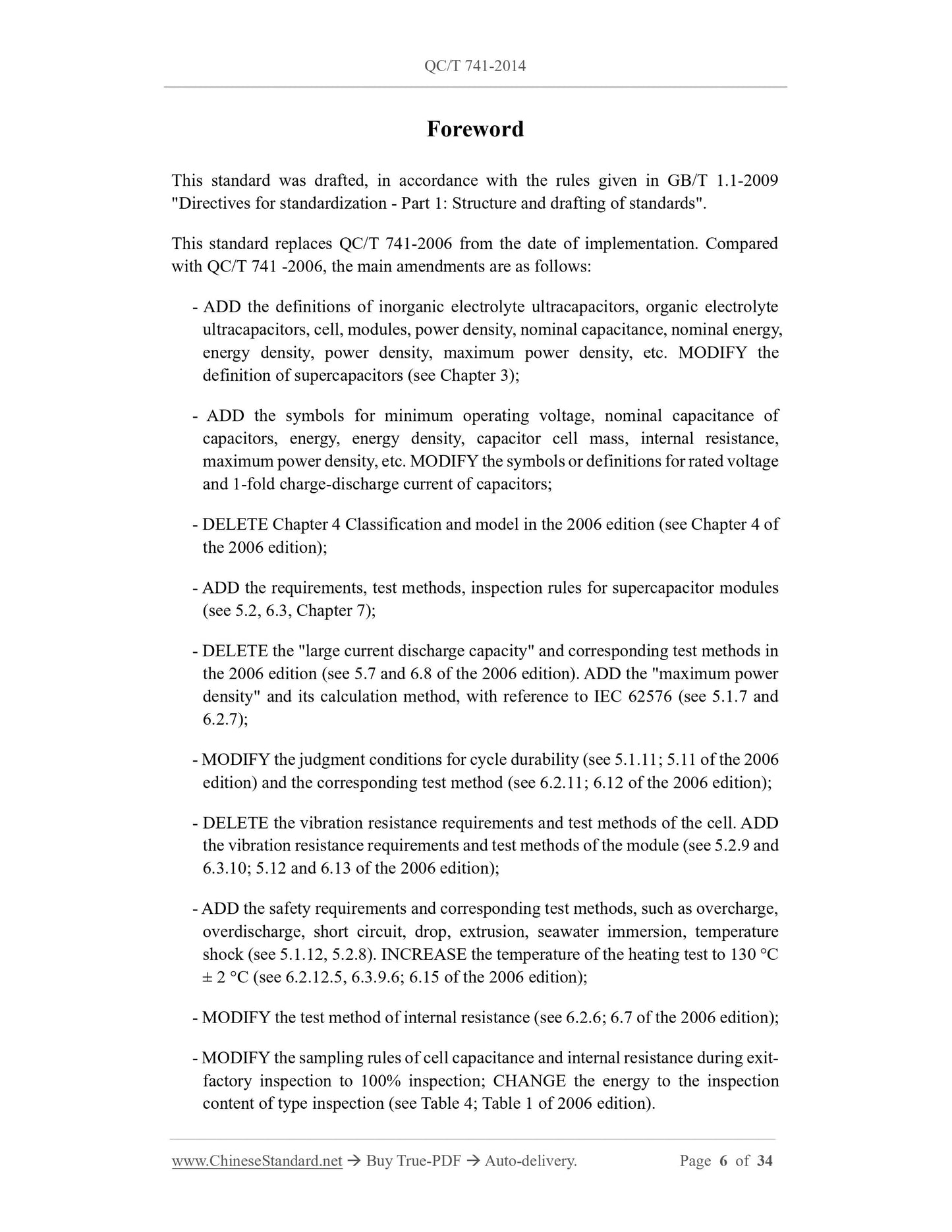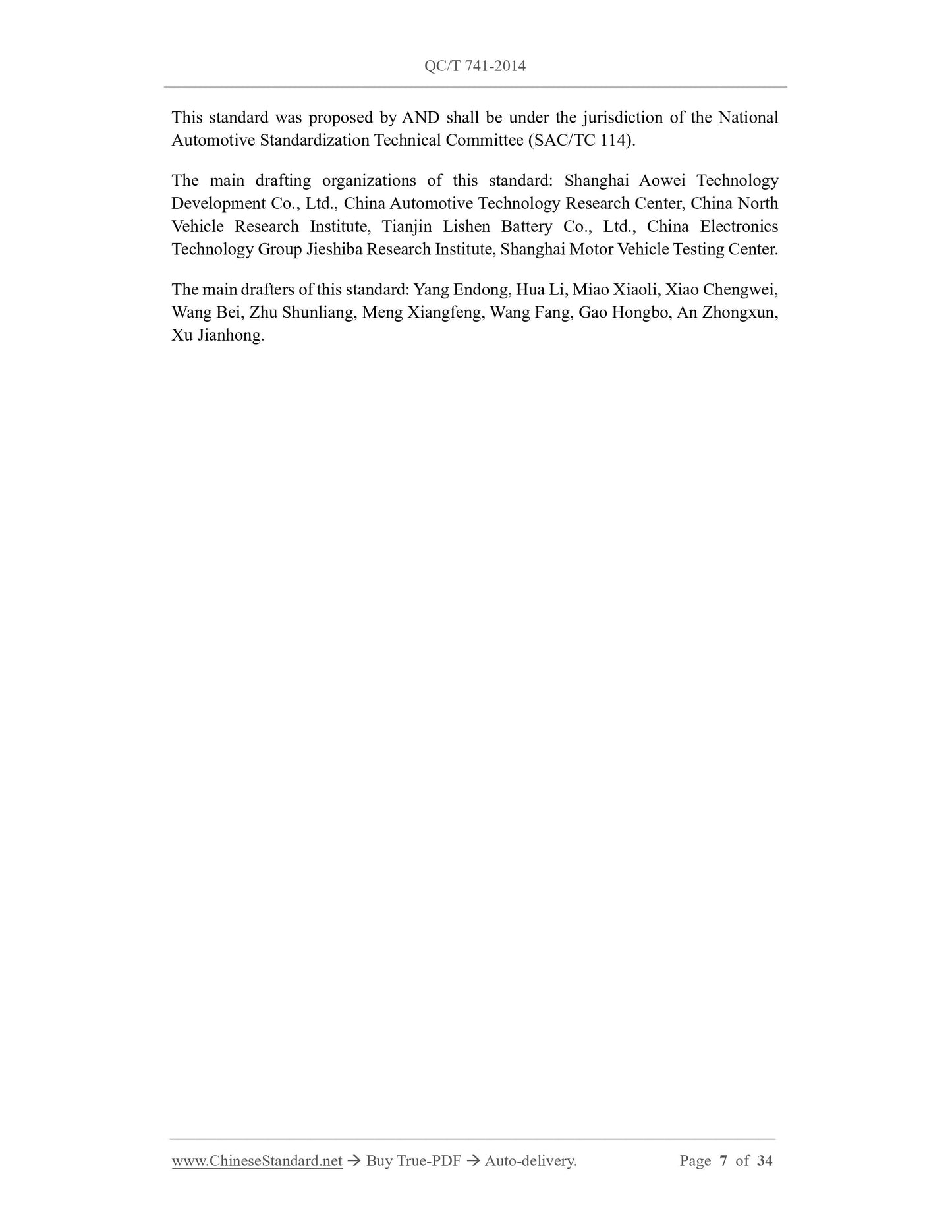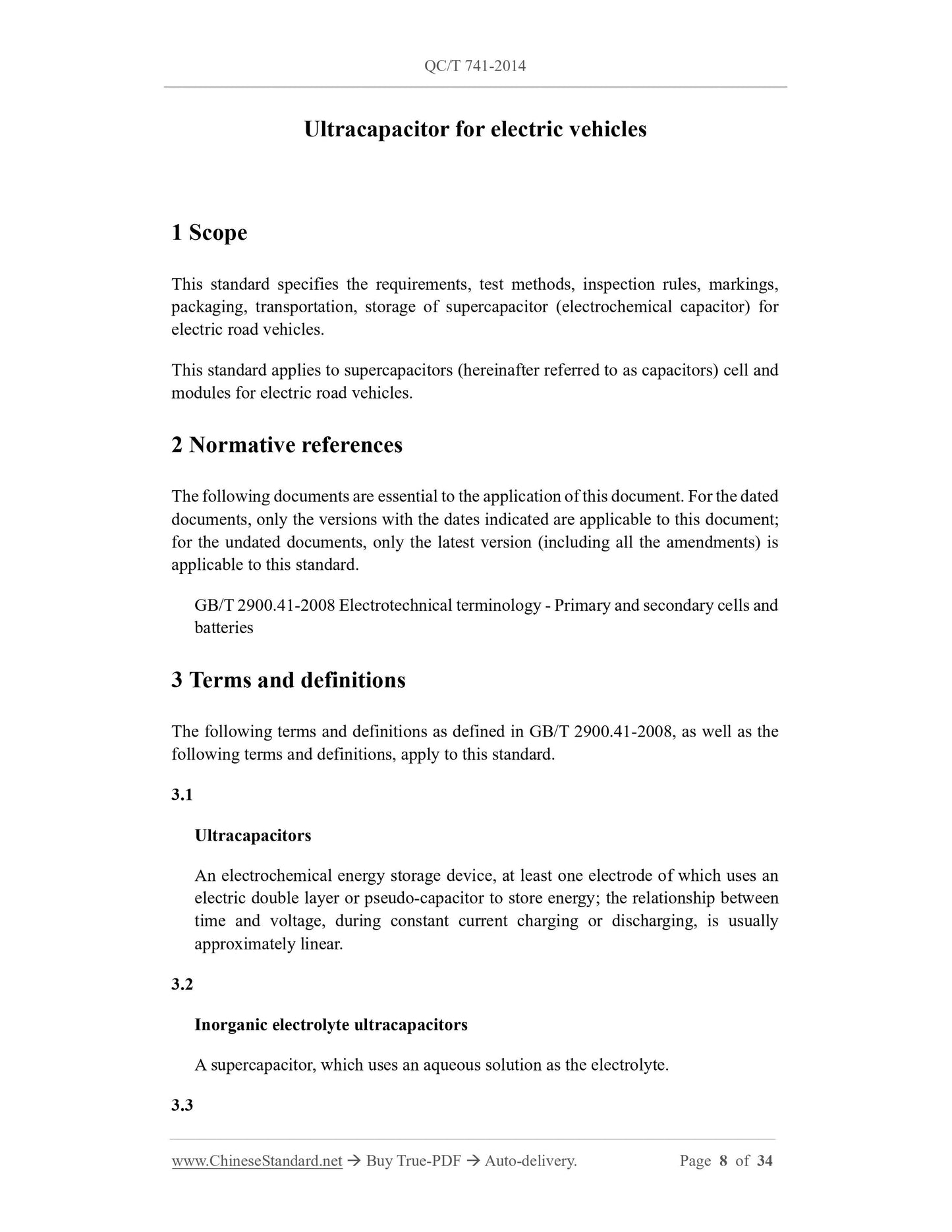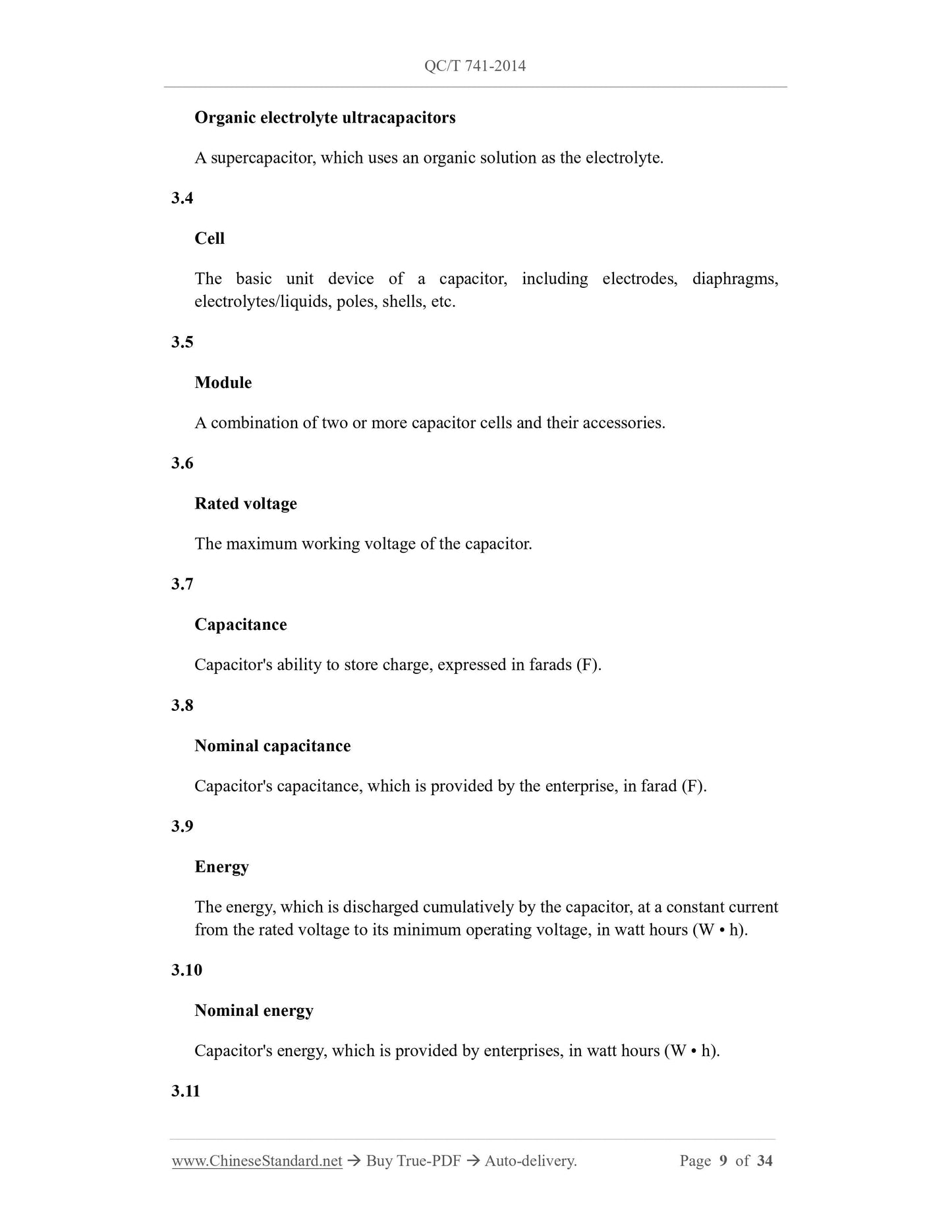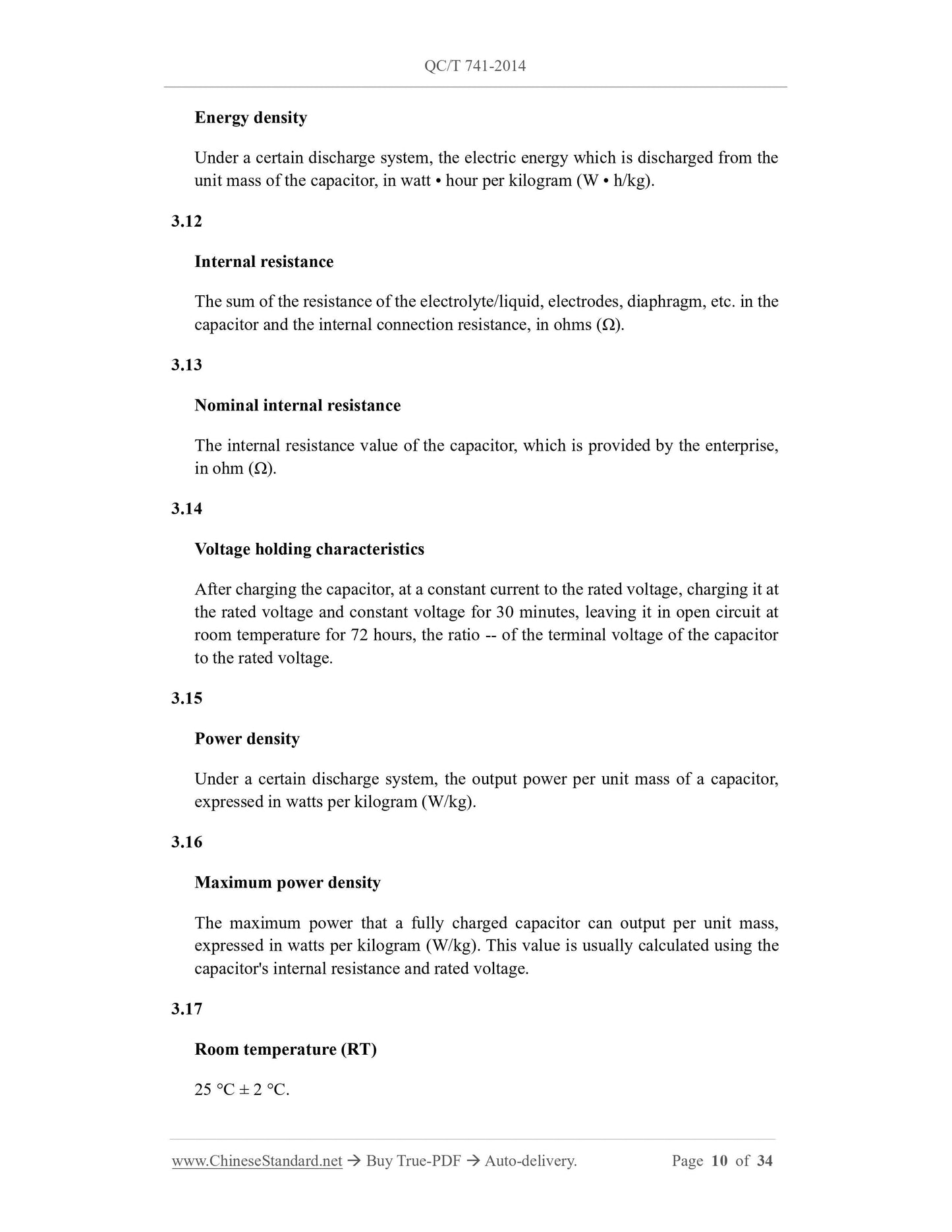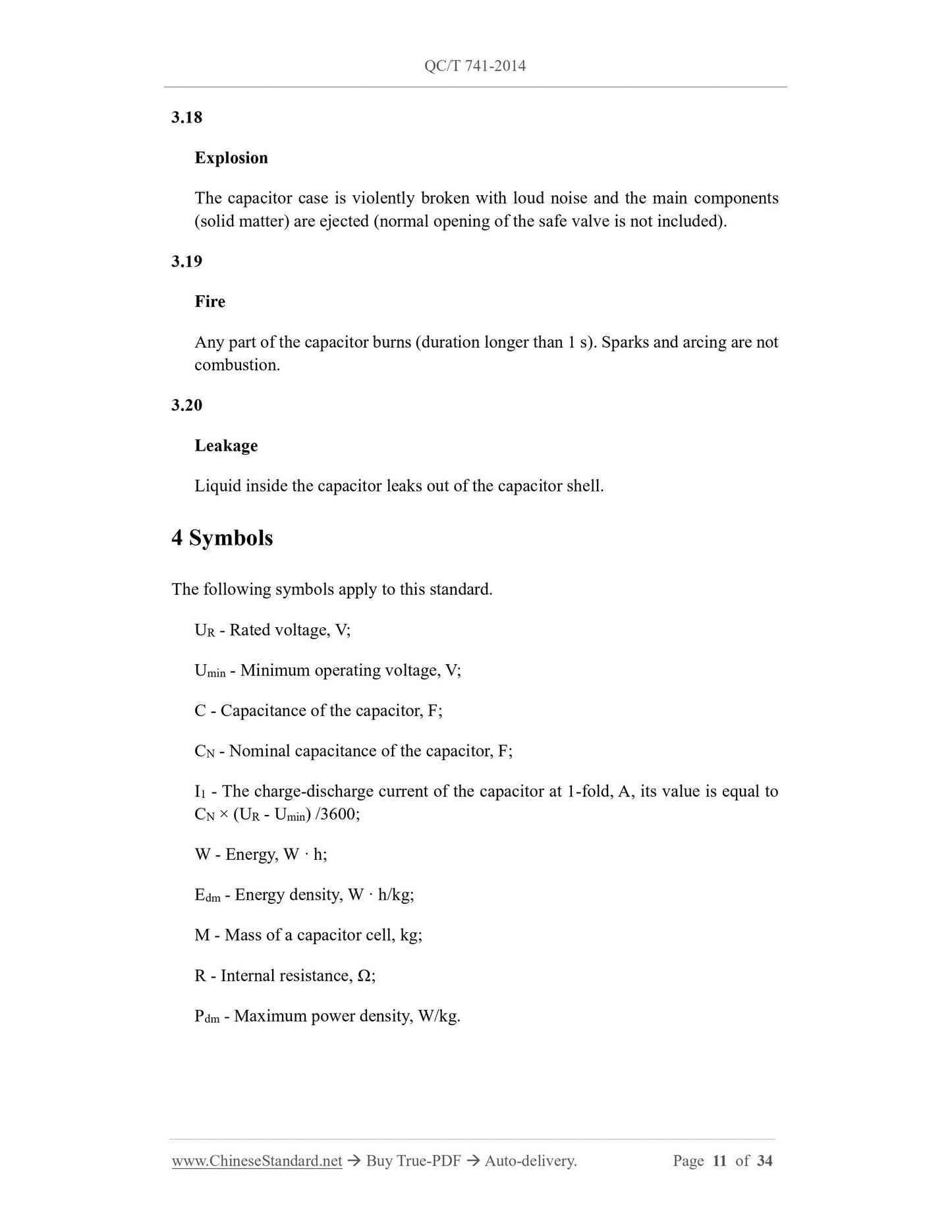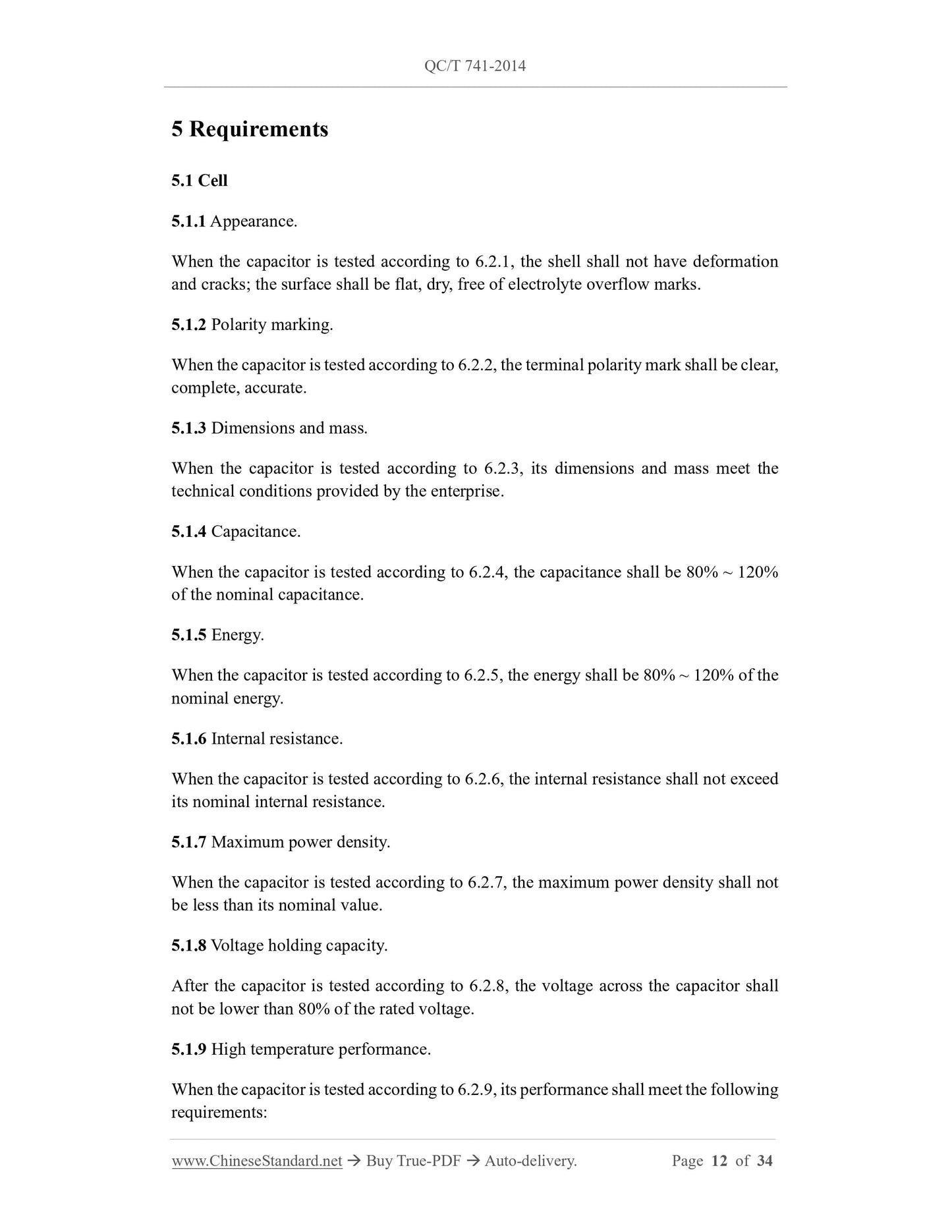PayPal, credit cards. Download editable-PDF & invoice in 1 second!
QC/T 741-2014 English PDF (QCT741-2014)
QC/T 741-2014 English PDF (QCT741-2014)
Precio habitual
$260.00 USD
Precio habitual
Precio de oferta
$260.00 USD
Precio unitario
/
por
Los gastos de envío se calculan en la pantalla de pago.
No se pudo cargar la disponibilidad de retiro
Delivery: 3 seconds. Download true-PDF + Invoice.
Get QUOTATION in 1-minute: Click QC/T 741-2014
Historical versions: QC/T 741-2014
Preview True-PDF (Reload/Scroll if blank)
QC/T 741-2014: Ultra-capacitor for electric vehicles (including Amendment List 2017XG1)
QC/T 741-2014
QC
AUTOMOBILE INDUSTRY STANDARD
OF THE PEOPLE’S REPUBLIC OF CHINA
ICS 43.080
T 47
Replacing QC/T 741-2006
Ultracapacitor for electric vehicles
(Including Amendment Sheet No.1 [2017XG1])
ISSUED ON: OCTOBER 14, 2014
IMPLEMENTED ON: APRIL 01, 2015
Issued by: Ministry of Industry and Information Technology of PRC
Table of Contents
Foreword ... 6
1 Scope ... 8
2 Normative references ... 8
3 Terms and definitions ... 8
4 Symbols ... 11
5 Requirements ... 12
6 Test method ... 15
7 Inspection rules ... 30
8 Marking, packaging, transportation, storage ... 32
Amendment Sheet No.1 [2017XG1] ... 34
Ultracapacitor for electric vehicles
1 Scope
This standard specifies the requirements, test methods, inspection rules, markings,
packaging, transportation, storage of supercapacitor (electrochemical capacitor) for
electric road vehicles.
This standard applies to supercapacitors (hereinafter referred to as capacitors) cell and
modules for electric road vehicles.
2 Normative references
The following documents are essential to the application of this document. For the dated
documents, only the versions with the dates indicated are applicable to this document;
for the undated documents, only the latest version (including all the amendments) is
applicable to this standard.
GB/T 2900.41-2008 Electrotechnical terminology - Primary and secondary cells and
batteries
3 Terms and definitions
The following terms and definitions as defined in GB/T 2900.41-2008, as well as the
following terms and definitions, apply to this standard.
3.1
Ultracapacitors
An electrochemical energy storage device, at least one electrode of which uses an
electric double layer or pseudo-capacitor to store energy; the relationship between
time and voltage, during constant current charging or discharging, is usually
approximately linear.
3.2
Inorganic electrolyte ultracapacitors
A supercapacitor, which uses an aqueous solution as the electrolyte.
3.3
- The capacitance is not lower than 80% of the initial value;
- The energy is not less than 80% of initial value.
5.1.10 Low temperature characteristics.
When the capacitor is tested according to 6.2.10, its performance shall meet the
following requirements:
- The capacitance is not lower than 60% of the initial value;
- The energy is not less than 50% of initial value.
5.1.11 Cycle life.
When the capacitor is tested according to 6.2.11, its performance shall meet the
following requirements:
- The capacitance of energy-type supercapacitors is greater than 80% of the initial
value, meanwhile the internal resistance is less than 2 times the initial value;
- The capacitance of power-type supercapacitor is greater than 90% of the initial
value, meanwhile the internal resistance is less than 1.5 times of the initial value;
- No electrolyte leakage.
5.1.12 Safety.
5.1.12.1 After passing the overdischarge test in 6.2.12.1, the capacitor cell shall not
explode, catch fire or leak.
5.1.12.2 After the capacitor cell is subjected to the overcharge test in 6.2.12.2, it shall
not explode or catch fire.
5.1.12.3 After the short-circuit test in 6.2.12.3, the capacitor cell shall not explode or
catch fire.
5.1.12.4 After the drop test of 6.2.12.4, the capacitor cell of the inorganic system shall
not explode or catch fire; the capacitors of the organic system shall not explode, catch
fire or leak.
5.1.12.5 When the capacitor cell is heated according to 6.2.12.5, it shall not explode or
catch fire.
5.1.12.6 After the extrusion test in 6.2.12.6, the capacitor cell shall not explode or catch
fire.
5.1.12.7 After subject to the acupuncture test specified in 6.2.12.7, the capacitor cell
shall not explode or catch fire.
5.1.12.8 After the capacitor cell is subjected to the seawater immersion test in 6.2.12.8,
it shall not explode or catch fire.
5.1.12.9 After the capacitor cell is subject to the temperature cycle test in 6.2.12.9, it
shall not explode, catch fire or leak.
5.2 Modules
5.2.1 Appearance.
When the capacitor module is inspected according to 6.3.2, the shell shall not have
deformation and cracks; the surface shall be dry; there shall be no electrolyte overflow
marks; the arrangement shall be neat and the connection shall be reliable.
5.2.2 Polarity marking.
When the capacitor module is inspected according to 6.3.3, the terminal polarity mark
shall be clear, complete, accurate.
5.2.3 Dimensions and mass.
When the capacitor module is inspected according to 6.3.4, its dimensions and mass
meet the technical conditions, which are provided by the enterprise.
5.2.4 Capacitance.
When the capacitor module is inspected according to 6.3.5, the capacitance shall be 80%
~ 120% of the nominal capacitance.
5.2.5 Energy.
When the capacitor module is inspected according to 6.3.6, the energy shall be 80% ~
120% of the nominal energy.
5.2.6 Internal resistance.
When the capacitor module is inspected according to 6.3.7, the internal resistance shall
not be greater than its nominal internal resistance.
5.2.7 Cycle life.
When the capacitor module is tested according to 6.3.8, its performance shall meet the
following requirements:
- The capacitance of the energy-type supercapacitor module is greater than 80% of
the initial value; the internal resistance is less than 2 times the initial value;
6.1.1.1 Unless otherwise specified, the capacitor shall be discharged, at a constant
current as specified by the enterprise, until its minimum operating voltage. Then it is
placed under the environmental conditions specified in 6.1.2 for 24 hours. The
performance of the capacitor shall be measured, as the basis for comparison after the
product test (however, the test environment before and after the test shall be consistent).
6.1.1.2 Charge-discharge current.
Unless otherwise specified, this standard applies to the following charge-discharge
currents:
- Energy-type capacitor: I = 5I1 (or a current not lower than 5I1 provided by the
enterprise);
- Power-type capacitor: I = 40I1 (or the current not lower than 40I1 provided by the
enterprise).
The type of capacitor is determined by the manufacturer.
6.1.2 Environmental conditions.
Unless otherwise specified, all measurements, tests, restorations are carried out in the
following environment:
- Temperature: 25 °C ± 5 °C;
- Relative humidity: 25% ~ 85%;
- Atmospheric pressure: 86 kPa ~ 106 kPa.
6.1.3 Measuring instruments and meters.
The accuracy of measuring instruments and meters shall meet the following
requirements:
- Voltage measuring device: The accuracy is not lower than grade 0.5; its internal
resistance is at least 1 kΩ/V;
- Current measuring device: The accuracy is not less than grade 0.5;
- Temperature measuring device: It has an appropriate range; its division value is not
greater than 1 °C; the calibration accuracy is not less than 0.5 °C;
- Timer: It is graduated in hours, minutes, seconds, with an accuracy of ±0.1%;
- Meters for measuring dimensions: The division value is not greater than 1 mm;
- Scales for weighing mass: Accuracy is ±0.05% or more.
6.2.9 High temperature characteristics.
Follow the steps below, to test the high temperature characteristics of capacitors:
a) Set the temperature of the temperature box to 55 °C or the maximum operating
temperature, which is not lower than 55 °C as specified by the enterprise;
b)...
Get QUOTATION in 1-minute: Click QC/T 741-2014
Historical versions: QC/T 741-2014
Preview True-PDF (Reload/Scroll if blank)
QC/T 741-2014: Ultra-capacitor for electric vehicles (including Amendment List 2017XG1)
QC/T 741-2014
QC
AUTOMOBILE INDUSTRY STANDARD
OF THE PEOPLE’S REPUBLIC OF CHINA
ICS 43.080
T 47
Replacing QC/T 741-2006
Ultracapacitor for electric vehicles
(Including Amendment Sheet No.1 [2017XG1])
ISSUED ON: OCTOBER 14, 2014
IMPLEMENTED ON: APRIL 01, 2015
Issued by: Ministry of Industry and Information Technology of PRC
Table of Contents
Foreword ... 6
1 Scope ... 8
2 Normative references ... 8
3 Terms and definitions ... 8
4 Symbols ... 11
5 Requirements ... 12
6 Test method ... 15
7 Inspection rules ... 30
8 Marking, packaging, transportation, storage ... 32
Amendment Sheet No.1 [2017XG1] ... 34
Ultracapacitor for electric vehicles
1 Scope
This standard specifies the requirements, test methods, inspection rules, markings,
packaging, transportation, storage of supercapacitor (electrochemical capacitor) for
electric road vehicles.
This standard applies to supercapacitors (hereinafter referred to as capacitors) cell and
modules for electric road vehicles.
2 Normative references
The following documents are essential to the application of this document. For the dated
documents, only the versions with the dates indicated are applicable to this document;
for the undated documents, only the latest version (including all the amendments) is
applicable to this standard.
GB/T 2900.41-2008 Electrotechnical terminology - Primary and secondary cells and
batteries
3 Terms and definitions
The following terms and definitions as defined in GB/T 2900.41-2008, as well as the
following terms and definitions, apply to this standard.
3.1
Ultracapacitors
An electrochemical energy storage device, at least one electrode of which uses an
electric double layer or pseudo-capacitor to store energy; the relationship between
time and voltage, during constant current charging or discharging, is usually
approximately linear.
3.2
Inorganic electrolyte ultracapacitors
A supercapacitor, which uses an aqueous solution as the electrolyte.
3.3
- The capacitance is not lower than 80% of the initial value;
- The energy is not less than 80% of initial value.
5.1.10 Low temperature characteristics.
When the capacitor is tested according to 6.2.10, its performance shall meet the
following requirements:
- The capacitance is not lower than 60% of the initial value;
- The energy is not less than 50% of initial value.
5.1.11 Cycle life.
When the capacitor is tested according to 6.2.11, its performance shall meet the
following requirements:
- The capacitance of energy-type supercapacitors is greater than 80% of the initial
value, meanwhile the internal resistance is less than 2 times the initial value;
- The capacitance of power-type supercapacitor is greater than 90% of the initial
value, meanwhile the internal resistance is less than 1.5 times of the initial value;
- No electrolyte leakage.
5.1.12 Safety.
5.1.12.1 After passing the overdischarge test in 6.2.12.1, the capacitor cell shall not
explode, catch fire or leak.
5.1.12.2 After the capacitor cell is subjected to the overcharge test in 6.2.12.2, it shall
not explode or catch fire.
5.1.12.3 After the short-circuit test in 6.2.12.3, the capacitor cell shall not explode or
catch fire.
5.1.12.4 After the drop test of 6.2.12.4, the capacitor cell of the inorganic system shall
not explode or catch fire; the capacitors of the organic system shall not explode, catch
fire or leak.
5.1.12.5 When the capacitor cell is heated according to 6.2.12.5, it shall not explode or
catch fire.
5.1.12.6 After the extrusion test in 6.2.12.6, the capacitor cell shall not explode or catch
fire.
5.1.12.7 After subject to the acupuncture test specified in 6.2.12.7, the capacitor cell
shall not explode or catch fire.
5.1.12.8 After the capacitor cell is subjected to the seawater immersion test in 6.2.12.8,
it shall not explode or catch fire.
5.1.12.9 After the capacitor cell is subject to the temperature cycle test in 6.2.12.9, it
shall not explode, catch fire or leak.
5.2 Modules
5.2.1 Appearance.
When the capacitor module is inspected according to 6.3.2, the shell shall not have
deformation and cracks; the surface shall be dry; there shall be no electrolyte overflow
marks; the arrangement shall be neat and the connection shall be reliable.
5.2.2 Polarity marking.
When the capacitor module is inspected according to 6.3.3, the terminal polarity mark
shall be clear, complete, accurate.
5.2.3 Dimensions and mass.
When the capacitor module is inspected according to 6.3.4, its dimensions and mass
meet the technical conditions, which are provided by the enterprise.
5.2.4 Capacitance.
When the capacitor module is inspected according to 6.3.5, the capacitance shall be 80%
~ 120% of the nominal capacitance.
5.2.5 Energy.
When the capacitor module is inspected according to 6.3.6, the energy shall be 80% ~
120% of the nominal energy.
5.2.6 Internal resistance.
When the capacitor module is inspected according to 6.3.7, the internal resistance shall
not be greater than its nominal internal resistance.
5.2.7 Cycle life.
When the capacitor module is tested according to 6.3.8, its performance shall meet the
following requirements:
- The capacitance of the energy-type supercapacitor module is greater than 80% of
the initial value; the internal resistance is less than 2 times the initial value;
6.1.1.1 Unless otherwise specified, the capacitor shall be discharged, at a constant
current as specified by the enterprise, until its minimum operating voltage. Then it is
placed under the environmental conditions specified in 6.1.2 for 24 hours. The
performance of the capacitor shall be measured, as the basis for comparison after the
product test (however, the test environment before and after the test shall be consistent).
6.1.1.2 Charge-discharge current.
Unless otherwise specified, this standard applies to the following charge-discharge
currents:
- Energy-type capacitor: I = 5I1 (or a current not lower than 5I1 provided by the
enterprise);
- Power-type capacitor: I = 40I1 (or the current not lower than 40I1 provided by the
enterprise).
The type of capacitor is determined by the manufacturer.
6.1.2 Environmental conditions.
Unless otherwise specified, all measurements, tests, restorations are carried out in the
following environment:
- Temperature: 25 °C ± 5 °C;
- Relative humidity: 25% ~ 85%;
- Atmospheric pressure: 86 kPa ~ 106 kPa.
6.1.3 Measuring instruments and meters.
The accuracy of measuring instruments and meters shall meet the following
requirements:
- Voltage measuring device: The accuracy is not lower than grade 0.5; its internal
resistance is at least 1 kΩ/V;
- Current measuring device: The accuracy is not less than grade 0.5;
- Temperature measuring device: It has an appropriate range; its division value is not
greater than 1 °C; the calibration accuracy is not less than 0.5 °C;
- Timer: It is graduated in hours, minutes, seconds, with an accuracy of ±0.1%;
- Meters for measuring dimensions: The division value is not greater than 1 mm;
- Scales for weighing mass: Accuracy is ±0.05% or more.
6.2.9 High temperature characteristics.
Follow the steps below, to test the high temperature characteristics of capacitors:
a) Set the temperature of the temperature box to 55 °C or the maximum operating
temperature, which is not lower than 55 °C as specified by the enterprise;
b)...
Share
